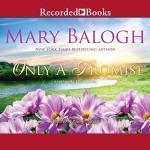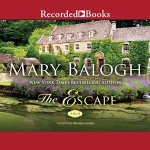 Narrated by Saskia Maarleveld
Narrated by Saskia Maarleveld
When I read The Jane Austen Project a few months back, I admit that I approached it with some trepidation. Two people travelling back in time to meet Jane Austen and retrieve a previously unpublished manuscript sounded – on the one hand – like a great premise, and on the other like a potential disaster. The author would have to be very careful with tone and characterisation to make it work – and I’m pleased to say that she strikes the right notes in both cases, displaying a thorough attention to period detail and portraying Jane Austen herself as the sort of witty, intelligent and insightful woman we imagine her to have been.
Austen devotee Doctor Rachel Katzman – a medical doctor who has spent most of her career working in the world’s flashpoints – and actor-turned-academic Professor Liam Finucane have been selected and trained by The Royal Institute for Special Topics in Physics to be able to take on the personas of Doctor William Ravenswood and his sister, Mary when they travel back in time to 1815. They arrive, disoriented and bedraggled in a field just outside Leatherhead in Surrey, with thousands of pounds worth of counterfeit money hidden beneath their clothes and a cover story that they have recently sold off their plantation in Jamaica, freed their slaves and come back to England to live. Unable to secure rooms at the nearest inn because of their lack of luggage and generally suspicious appearance, they hire a chaise and head straight to London where they go about the task of setting themselves up at a respectable address, kitting themselves out as befits a couple of independently wealthy siblings and generally orienting themselves to their new lives in 1815.
Their plan is to insert themselves into the friendship circle of Henry Austen, whom Jane referred to in her letters as her favourite brother. A forged letter of introduction purporting to be from an acquaintance of a distant Austen relative is well received by Henry and he invites Liam to meet with him at his club. Rachel is rather frustrated by this, but is well aware that women in 1815 did not have as much freedom as men and knows she cannot be part of this first meeting. Fortunately, things go well, they are invited to dinner, and over the next few weeks, become part of Henry’s intimate circle, eventually securing the invitation they have been angling for – to meet his sister Jane, and other family members when they next visit London.
Liam and Rachel have several goals. One is to find and bring back the manuscript of The Watsons, a novel previously thought unfinished but which new evidence reveals was finished but never published; the others are to obtain some more of Jane’s letters to her sister Cassandra, and find out what mysterious illness killed Jane at the age of just forty-one. Things go mostly according to plan; Liam and Rachel are welcomed into the Austen’s circle and over the next weeks and months – and after an initially shaky start – Rachel and Jane forge a strong friendship, which presents Rachel with quite the ethical dilemma. The idea of stealing a manuscript and making a great literary discovery in the abstract was one thing. Stealing from a woman she is coming to regard as a close friend is a different matter entirely.
Time travel fiction is always going to have to deal with one big problem, namely, how can people go back in time without somehow affecting the present and the future? Liam and Rachel are warned not to do anything that could potentially change the probability fields of time but they come to realise that just by simply being where and when they shouldn’t be they are changing things without even intending to. As they get to know Henry and Jane as real people and not just historical figures they’ve read about in books, the temptation to help them – to prevent Henry being ruined when his bank fails in 1816, or to prevent Jane’s early death – are almost irresistible, and they both start to wonder if the world to which they will return will be changed out of all recognition and think seriously about remaining in 1815 in a world which, over the months of their stay, has come to seem more real to them than they could ever have imagined.
One of the things I’d been worried about when I started reading the book was the character of Rachel, an American doctor of the future (it’s never made completely clear when Liam and Rachel are from, although the author does drop some interesting hints and snippets of information about their world) and whether she would fit into the early nineteenth century without making lots of mistakes and being too aggressively modern. Fortunately, Ms. Flynn avoids that trap, having Rachel well aware of the restrictions placed on women of the time and adhering to them while wondering how on earth intelligent women of the time didn’t go insane.
Thrown into continual proximity and being the only two people who know the truth, it’s natural that Liam and Rachel would become close, and eventually, embark upon a romantic and sexual relationship. In the manner of many an Austen heroine, Rachel comes to examine her own thoughts and emotions and to draw some unexpected conclusions about herself, but this is just one of the different elements that comprise this entertaining and unusual story. Ms. Flynn paints a detailed and accurate portrait of life as lived by the middle classes in Regency England, and I particularly enjoyed her interpretations of the various Austen family members and their familial relationships.
When I saw Saskia Maarleveld listed as narrator for this book, the word that came immediately to mind was “perfect.” I already know Ms. Maarleveld is adept at narrating historical romances, and that she’s someone whose American accent is – to my ears – every bit as good as her English one, and that she is able to switch between the two seamlessly. There is a fairly large cast of characters, but she differentiates them all effectively, giving Jane a nicely modulated, serene quality and using a fairly low pitch close to her own natural register, adopting a slightly harder edge for Cassandra and a slightly higher pitch and polished accent for 1815-Rachel. Because the story is told completely in Rachel’s PoV, Ms. Maarleveld performs the narrative using an American accent, and uses it for much of Rachel’s dialogue when she is private with Liam. There are something like three or four different men featured in the story apart from Liam and Henry – Jane’s other brothers and a family friend or two, and all of them are distinguishable from one another. Once or twice I thought that Henry and Liam sounded a little too similar, but most of the time that wasn’t an issue. Ms. Maarleveld also made good use of a couple of regional accents, most noticeably an Irish one for Liam which he reverted to occasionally and in times of pressure. Or inebriation ;)
The Jane Austen Project is a creative and enjoyable story that addresses some interesting themes at the same time as being a cracking good yarn. Saskia Maarleveld does a fabulous job with the narration, and if you’re looking for a piece of historical fiction that’s a little out of the ordinary you could do a lot worse than give it a try.
Note: The Jane Austen Project contains romantic elements, but is not categorised as a Romance. There is no HEA and the ending for Liam and Rachel is ambiguous. However, I choose to believe they will, as Liam says at the end, “work something out.”
Caz
Buy The Jane Austen Project by Kathleen A. Flynn on Amazon




1 thought on “The Jane Austen Project by Kathleen A. Flynn”
Comments are closed.